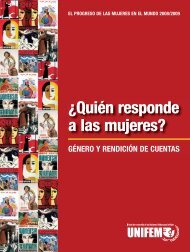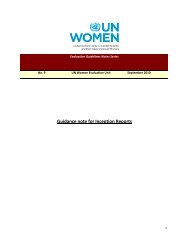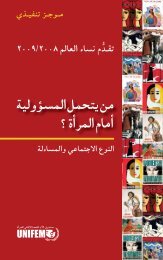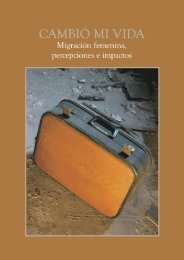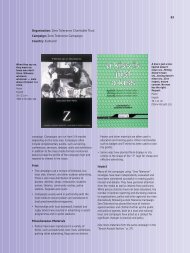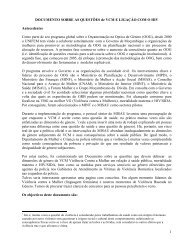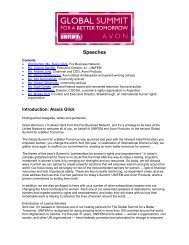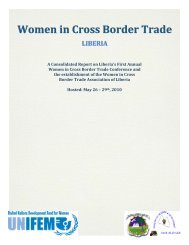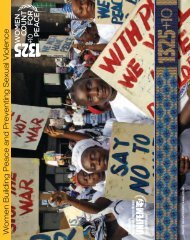Create successful ePaper yourself
Turn your PDF publications into a flip-book with our unique Google optimized e-Paper software.
Encadré 2A : Définitions<br />
i Molyneux, M. 1985. “Mobilization without Emancipation?<br />
<strong>Women</strong>’s Interests, the State, and Revolution in<br />
Nicaragua.” Feminist Studies 11(2), pp. 227-254.<br />
Encadré 2B : Les manifestes de femmes<br />
i National <strong>Women</strong>’s Council of Ireland. 2007. What <strong>Women</strong><br />
Want from the Next Irish Government. Consulté<br />
le 23 juin 2008, à http://www.nwci.ie/publications/published_reports/what_women_want_from_the_next_<br />
irish_government_nwci_election_2007_manifesto.<br />
ii Selolwane, O. D. (à paraître). “From Political Sidecars<br />
to Legislatures: <strong>Women</strong> and Party Politics in Southern<br />
Africa.” In A. M. Goetz (Ed.), Governing <strong>Women</strong>:<br />
<strong>Women</strong>’s Political Effectiveness in Contexts of Democratization<br />
and Governance Reform. New York :<br />
Routledge.<br />
Encadré 2C : Le mouvement anti-alcool de 1990<br />
dans l’Andhra Pradesh<br />
i Larsson, M. 2006. “When <strong>Women</strong> Unite!” The Making<br />
of the Anti-Liquor Movement in Andhra Pradesh,<br />
India. Stockholm: Stockholm University Press, pp.<br />
115-120.<br />
ii Ibid, pp. 5-8.<br />
iii Ibid, pp. 190-192.<br />
Encadré 2D : Quotas pour les femmes<br />
i Base de données de l’Union interparlementaire (UIP).<br />
« Les femmes au parlement ». Consultée le juillet<br />
2008, à http://www.ipu.org/wmn-f/world.htm; Base<br />
de données mondiale des quotas pour les femmes,<br />
IDEA, 2008. Consultée en juillet 2008, à http://www.<br />
quotaproject.org/.<br />
Encadré 2E : GABRIELA s’en va au Congrès<br />
i Matériels élaborés à partir des sources suivantes :<br />
Commission électorale, République des Philippines.<br />
Consulté le 30 juillet 2008, à www.comelec.gov.ph;<br />
Congrès des Philippines, Chambre des représentants;<br />
et Parti des femmes Gabriela, “About Gabriela’s<br />
<strong>Women</strong>’s Party.” Consulté le 30 juillet 2008, à http://<br />
gabrielawomensparty.net/about.<br />
Encadré 2F : Genre et corruption<br />
i Mason, A. D., & King, E. M. January 2001. “Engendering<br />
development through gender equality in rights,<br />
resources, and voice.” World Bank Policy Research<br />
Report, 1(21776), p. 96.<br />
ii Sung, H.-E. 2003. “Fairer Sex or Fairer System Gender<br />
and Corruption Revisited.” Social Forces, 82(2),<br />
pp. 703-723.<br />
Encadré 2G : Femmes parlementaires et extrants<br />
politiques<br />
i Bratton, K., & Ray, L. 2002. “Descriptive Representation,<br />
Policy Outcomes, and Municipal Day-Care<br />
Coverage in Norway.” American Journal of Political<br />
Science 46(2), pp. 648-657.<br />
ii Chattopadhyay, R., & Dufl o, E. 2004. “Woman as<br />
Policy Makers: Evidence from a Randomized Policy<br />
Experiment in India.” Econometrica 72(5), pp. 1409-<br />
1443.<br />
iii Ibid, p. 1432.<br />
Chapitre 3 : Services<br />
1 Bureau de la Conseillère spéciale pour la parité des<br />
sexes et la promotion de la femme. 2006. L’équité<br />
entre les sexes, l’eau et l’assainissement : Études de<br />
cas sur les meilleures pratiques. Consulté le 28 mai<br />
2008, à http://www.un.org/womenwatch/osagi/pdf/<br />
GenderWaterSanitation/English%20full.pdf,<br />
pp. 9 - 14.<br />
2 Shiffman, J., Stanton, C., & Salazar, P. 2004. “The<br />
Emergence of Political Priority for Safe Motherhood<br />
in Honduras.” Health and Policy Planning, 19(6), pp.<br />
380-390.<br />
3 King, E., & Mason, A. 2001. “Engendering Development<br />
Through Gender Equality in Rights, Resources<br />
and Voice.” World Bank Policy Research Report.<br />
Oxford et Washington D.C.: Oxford University Press<br />
et Banque mondiale, p. 152; <strong>UN</strong>ESCO. 2003. « Pourquoi<br />
les fi lles restent-elles bloquées ? » In Rapport<br />
mondial de suivi sur l’EPT 2003/4; BRIDGE. 1995.<br />
Background Report on Gender Issues in India: Key<br />
Findings and Recommendations. Brighton : Institute<br />
of Development Studies (IDS), p. 4.<br />
4 Voir, par exemple : Peters, D. 2001. “Breadwinners,<br />
Homemakers and Beasts of Burden: A Gender<br />
Perspective on Transport and Mobility.” Sustainable<br />
Development International. Consulté le 3 juin 2008,<br />
à http://www4.worldbank.org/afr/ssatp/Resources/<br />
HTML/Gender-RG/Source%20%20documents/Issue<br />
%20and%20Strategy%20Papers/G&T%20Rationale/<br />
ISGT5%20Breadwinners,Burden%20Peters.pdf.<br />
5 Programme des Nations Unies pour le développement<br />
(PNUD). 2006. Rapport mondial sur le développement<br />
humain 2006 : Au-delà de la pénurie :<br />
Pouvoir, pauvreté et la crise mondiale de l’eau. Paris :<br />
Economica, p. 47.<br />
6 Banque mondiale. 2005. Improving <strong>Women</strong>’s Lives:<br />
World Bank Actions Since Beijing. Washington, D.C.:<br />
The World Bank Gender and Development Group, p.<br />
11.<br />
7 Programme des Nations Unies pour l’environnement<br />
(PNUE). 2004. “In Search of Water, Young Mothers<br />
Mobilize on Multiple Fronts.” <strong>Women</strong> and Water Management:<br />
An Integrated Approach. Consulté le 27<br />
avril 2008, à www.unep.org/pdf/women/ChapitreFive.<br />
pdf, pp. 76-78.; Voir also MAMA-86. “Drinking Water<br />
in Ukraine.” Consulté le 18 mai 2008, à http://www.<br />
mama-86.org.ua/drwater/drwater_e.htm.<br />
8 Houtzager, P. P. & Pattenden, J. 1999. Finding the<br />
Shape of the Mountain: When ‘the Poor’ Set the<br />
National Agenda. Paper presented at the Workshop<br />
on Political Systems and Poverty Alleviation, Castle<br />
Donnington, Royaume-Uni, 12 août 1999, pp. 21-26.<br />
9 Voir, par exemple, Banque mondiale. 2003. Rapport<br />
sur le développement dans le monde 2004 :<br />
Les services au service des populations pauvres.<br />
Washington D.C.: Banque mondiale et Oxford University<br />
Press.<br />
10 Ibid, pp. 1, 6-7.<br />
11 <strong>Women</strong>’s Dignity Project/ Utu Mwanamke. 2004.<br />
“In Their Own Words: Poor <strong>Women</strong> and Health<br />
Services.” Consulté le 27 avril 2008, à http://www.<br />
womensdignity.org/In_their_own_words.pdf, p. 2.<br />
12 Les raisons qui font que les personnels médicaux<br />
urbains éduqués hésitent à accepter des postes dans<br />
les zones rurales éloignées sont examinées dans<br />
Banque mondiale. 2004, pp. 22-23, 135.<br />
13 Banque mondiale. 2003. p. 5.<br />
14 Porter, G. 2007. Transport, (Im)Mobility, and Spatial<br />
Poverty Traps: Issues for Rural <strong>Women</strong> and Girl<br />
Children in Sub-Saharan Africa. Exposé présenté<br />
au ‘Understanding and Addressing Spatial Poverty<br />
Traps: An International Workshop,’ p. 3.<br />
15 King, E., & Mason, A. 2001. pp. 20, 176.<br />
16 Nyamu-Musembi, C. 2008. “Ruling Out Gender<br />
Equality? The Post-Cold War Rule of Law Agenda in<br />
Sub-Saharan Africa.” In A. M. Goetz (Ed.), Governing<br />
<strong>Women</strong>. Londres : Routledge, p. 283.<br />
17 Deere, C. D., & León, M. 2000. Género, propiedad<br />
y empoderamiento: tierra, estado y mercado en<br />
América Latina. Bogotá: Tercer Mundo; Deere, C.<br />
D., & León, M. 2001 Empowering <strong>Women</strong>: Land<br />
and Property Rights in Latin America. University of<br />
Pittsburgh Press, Pittsburgh, Penn., cité par le Centre<br />
de recherches pour le développement international<br />
(CRDI), Land and Development in Latin America,<br />
Perspectives from Research. Consulté le 28 mai<br />
2008, à http://www.crdi.ca/livres/ev-71216-201-1-<br />
DO_TOPIC.html#ref-4-146.<br />
18 Banque mondiale. 2007. “The Gender Dimensions.”<br />
Rapport sur le développement dans le monde 2008 :<br />
L’agriculture au service du développement. Washington<br />
D.C.: Banque mondiale, p. 1.<br />
19 Réseau d’information en matière de population (Nations<br />
Unies). 1995. “Modules on Gender, Population<br />
& Rural Development with a Focus on Land Tenure<br />
& Farming Systems.” FAO, Population Programme<br />
Service, Rome. Consulté le 5 juin 2008, à http://www.<br />
un.org/popin/fao/faomod/mod3.html.<br />
20 Corbridge, S. & Kumar, S. 2002. “Programmed to<br />
fail?” Journal of Development Studies, 39(2), pp. 73-<br />
104.<br />
21 Staudt, K. 1978. “Agricultural Productivity Gaps: A<br />
Case Study of Male Preference in Government Policy<br />
Implementation.” Development and Change, 9(3), pp.<br />
439-457.<br />
22 Banque mondiale. 2007. p. 1.<br />
23 Wennick, B., Nederlof, S., & Heemskerk, W. (Eds.).<br />
2007. Access of the Poor to Agricultural Services:<br />
The Role of Farmers’ Organizations and Social Inclusion,<br />
p. 48.<br />
24 Glick, Saha and Younger montrent que les avantages<br />
de l’emploi dans le secteur public échoient principalement<br />
aux hommes, alors que les femmes et les fi lles,<br />
chargées au premier chef de la corvée d’eau, bénéfi<br />
cieraient davantage d’investissements dans l’infrastructure<br />
de l’adduction d’eau; Glick, P., Saha, R., &<br />
Younger, S. D. 2004. Integrating Gender into Benefi t<br />
Incidence and Demand Analysis. Consulté le 26 juin<br />
2008, à www.cfnpp.cornell.edu/images/wp167.pdf.<br />
25 <strong>UN</strong>IFEM. 2008. <strong>UN</strong>IFEM Quarterly Newsletter, Issue<br />
1. Consultée le 5 juin 2008, à http://www.genderbudgets.org/component/option,com_docman/<br />
task,doc_view/gid,357/, p. 1.<br />
26 Financial Management Reform Project (FMRP). 2007.<br />
Governance, Management and Performance in<br />
Health and Education Facilities in Bangladesh: Findings<br />
from the Social Sector Performance Qualitative<br />
Study. Oxford et Dhaka: Oxford Policy Management,<br />
Financial Management Reform Programme, Ministry<br />
of Finance, Government of Bangladesh, p. 24, Encadré<br />
1.<br />
27 Ibid.<br />
28 Commonwealth Human Rights Initiative. 2005. Police<br />
Accountability: Too Important to Neglect, Too Urgent<br />
to Delay. New Delhi : Commonwealth Human Rights<br />
Initiative, p. 9; Chattoraj, B. Sex Related Offenses<br />
and Their Prevention and Control Measures: An<br />
Indian Perspective. 133 rd International Training Course<br />
Visiting Experts’ Papers. Consulté le 5 juin 2008,<br />
à http://www.unafei.or.jp/english/pdf/PDF_rms/<br />
no72/12_P82-99.pdf.<br />
29 <strong>UN</strong>ESCO. 2003; Dunne, M., Humphrys, S. & Leach,<br />
F. 2003. “Gender and Violence in Schools.” Document<br />
de travail pour l’<strong>UN</strong>ESCO, p. 143.<br />
144 LE PROGRÈS DES FEMMES À TRAVERS LE MONDE 2008/2009



